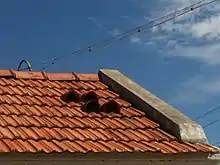Roof tiles
Roof tiles are overlapping tiles designed mainly to keep out rain or snow, and are traditionally made from locally available materials such as clay or slate. Later tiles have been made from materials such as concrete, and plastic.

Roof tiles can be affixed by screws or nails, but in some cases historic designs such as Mangalore tiles utilize interlocking systems that are self-supporting. Tiles typically cover an underlayment system, which seals the roof against water intrusion.[1]
Categories
There are numerous profiles, or patterns, of roof tile, which can be separated into categories based on their installation and design.
Shingle / flat tiles
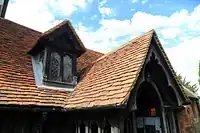
One of the simplest designs of roof tile, these are simple overlapping slabs installed in the same manner as traditional shingles, usually held in place by nails or screws at their top. All forms of slate tile fall into this category. When installed, most of an individual shingle's surface area will be covered by the shingles overlapping it. As a result of this, flat tiles require more tiles to cover a certain area than other patterns of similar size.[2]
These tiles commonly feature a squared base, as is the case with English clay tiles, but in some cases can have a pointed or rounded end, as seen with the beaver-tail tile common in Southern Germany.
Imbrex and tegula

The imbrex and tegula are overlapping tiles that were used by many ancient cultures, including the Greeks, Romans, and Chinese. The tegula is a flat tile laid against the surface of the roof, while the imbrex is a semi-cylindrical tile laid over the joints between tegulae.
In early designs tegula were perfectly flat, however over time they were designed to have ridges along their edges to channel water away from the gaps between tiles.[3]
Mission / Monk and Nun tiles

Similar to the imbrex and tegula design of tile, mission tiles are a semi-cylindrical two-piece tile system, composed of a pan and cover. Unlike the imbrex and tegula both the pan and cover of Mission tile are arched.
Early examples of this profile were created by bending a piece of clay over a worker's thigh, which resulted in the semi-circular curve. This could add a taper to one end of the tile.
Pantiles / S tiles
.jpg.webp)
Pantiles are similar to mission tiles except that they consolidate the pan and cover into a single piece. This allows for greater surface area coverage with less tiles, and fewer cracks that could lead to leakage.
These tiles are traditionally formed through an extruder. In addition to the "S" shaped Spanish tiles, this category includes the Scandia tiles common to Scandinavia and Northern Europe.
Interlocking tiles
Dating to the 1840s, interlocking tiles are the newest category of roofing tile and one of the widest ranging in appearance.[4] Their distinguishing feature is the presence of a ridge for interlocking with one another. This allows them to provide a high ratio of roof area to number of tiles used. Many distinct profiles fall into this category, such as the Marseilles and Conosera profiles.[5]
Unlike other types of tiles, which can in some cases be produced through a variety of methods, interlocking tiles can only be manufactured on a large scale with a tile press.
In many cases interlocking tile is designed to imitate other patterns of tile, such as flat shingles or pantiles, which can make it difficult to identify from the ground without inspecting an individual tile for a ridge.[6]
History as a vernacular material
Asia
Clay, or terracotta, tiled roofs first replaced thatched roofs in ancient Mesopotamia.[7] Although house models from Indus Valley Civilization show that the houses were flat roofed,[8] Harappan sites such as Alamgirpur (dated 2600–2200 BCE) provide evidence of roof tiles.[9]
China

Clay roof tiles are the main form of historic ceramic tilework in China, due largely to the emphasis that traditional Chinese architecture places on a roof as opposed to a wall.[10] Tiles have been used as roofing in China since the Zhou Dynasty. During the Song Dynasty, the manufacture of glazed tiles were standardized in Li Jie's Yingzao Fashi.[11] In the Ming Dynasty and Qing Dynasty, glazed tiles became ever more popular for top-tier buildings, including palace halls in the Forbidden City and ceremonial temples such as the Heavenly Temple.
Chinese architecture is notable for its advancement of colored gloss glazes for roof tiles. Marco Polo made note of these on his travels to China:[12]
— The roof is all ablaze with scarlet and green and blue and yellow and all the colors that are, so brilliantly varnished that it glitters like crystal and the color of it can be seen from far away.
Japan
Japanese architecture includes Onigawara as roof ornamentation in conjunction with tiled roofs. They are generally roof tiles or statues depicting a Japanese ogre (oni) or a fearsome beast. Prior to the Heian period, similar ornaments with floral and plant designs "hanagawara" preceded the onigawara.
Onigawara are most often found on Buddhist temples. In some cases the ogre's face may be missing.[13]
Korea
.jpg.webp)
In Korea the use of tile, known as giwa, dates back to the Three Kingdoms Period, but it wasn't until the Unified Silla Period that tile roofing became widely used. Tiles were initially reserved for temples and royal buildings as a status symbol.
The designs used on giwa can have symbolic meanings, with different figures representing concepts such as spirituality, longevity, happiness, and enlightenment. The five elements of fire, water, wood, metal and earth were common decorations during the Three Kingdoms Period, and during the Goryeo Dynasty Celadon glaze was invented and used for the roof tiles of the upper class.
Many post-war Korean roofs feature giwa and a common ornamental symbol is the Mugunghwa, South Korea's national flower. [14]
Greece
Fired roof-tiles have been found from as early as 2500–2300 BC in the Early Helladic House of the tiles in Lerna, Greece.[15][16] Debris found at the site contained thousands of terracotta tiles which had fallen from the roof.[17] In the Mycenaean period, roof tiles are documented for Gla and Midea.[18]
The earliest roof tiles from the Archaic period in Greece are documented from a very restricted area around Corinth, where fired tiles began to replace thatched roofs at two temples of Apollo and Poseidon between 700 and 650 BC.[19] Spreading rapidly, roof tiles were found within fifty years at many sites around the Eastern Mediterranean, including Mainland Greece, Western Asia Minor, and Southern and Central Italy.[20] Early Greek roof-tiles were of the imbrex and tebula style.[21] While more expensive and labour-intensive to produce than thatch, their introduction has been explained by their greatly enhanced fire-resistance which gave desired protection to the costly temples.[22]
The spread of the roof-tile technique has to be viewed in connection with the simultaneous rise of monumental architecture in Ancient Greece. Only the newly appearing stone walls, which were replacing the earlier mudbrick and wood walls, were strong enough to support the weight of a tiled roof.[23] As a side-effect, it has been assumed that the new stone and tile construction also ushered in the end of 'Chinese roof' (Knickdach) construction in Greek architecture, as they made the need for an extended roof as rain protection for the mudbrick walls obsolete.[24]
A Greek roof tile was responsible for the death of Molossian king Pyrrhus of Epirus in 272 B.C. after a woman threw one at the king's head as he was attacking her son.[25]
Roman Empire
Roof tiles similar to Greek designs continued to be used through the reign of the Roman Empire. They were a common feature in Roman cities, despite the fact that a single tile would often cost the equivalent of 1.5 day's wages. Tiles were commonly used as improvised weapons used during citizen uprisings, as they were one of few such weapons available to city-dwellers of the time.[26]
Roman imbrex and tebula roofs generally avoided the use of nails and were instead held in place through gravity, it is possible that this was one of the reasons their tile was found on low pitched roofs.[27]
The Romans spread the use and production of roofing tile across their colonies in Europe, with kilns and tile-works constructed as far west and north as Spain and Britain. Early records suggest that brick and tile-works were considered under the control of the Roman state for a period of time.[28]
Northern Europe
It is believed that the Romans introduced the use of clay roof tile to Britain after their conquest in 43 A.D. The earliest known sites for the production of roof tile are near the Fishbourne Roman Palace. Early tiles produced in Britain followed the Roman imbrex and tebula style, but also included flat shingle tiles, which could be produced with less experience.[29]
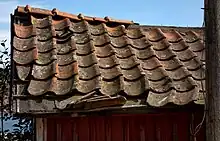
For a while after the dissolution of the Roman Empire, the manufacture of tile for roofs and decoration diminished in Northern Europe. In the twelfth century clay, slate, and stone roofing tile began to see more use, initially on abbeys and royal palaces. Their use was later encouraged within Medieval towns as a means of preventing the spread of fire. Simple flat shingle tiles became common during this period due to their ease of manufacture.[30]
Scandinavian roof tiles have been seen on structures dating to the 1500s when city rulers in Holland required the use of fireproof materials. At the time, most houses were made of wood and had thatch roofing, which would often cause fires to spread quickly. To satisfy demand, many small roof-tile makers began to produce roof tiles by hand. The Scandinavian style of roof tile is a variation on the pantile which features a subdued "S" shape reminiscent of an ocean wave.[31]
In Britain, tiles were also used to provide weather protection to the sides of timber frame buildings, a practice known as tile hanging.[32] Another form of this is the so-called mathematical tile, which was hung on laths, nailed and then grouted. This form of tiling gives an imitation of brickwork and was developed to give the appearance of brick, but avoided the brick taxes of the 18th century.[33]
North America
Roof tiles were introduced to North America by colonizers from Europe, and typically were traditional designs native to their original country.
Pieces of clay roof tile have been found in archeological excavations of the English settlement at Roanoke Colony dating to 1585, and in later English settlements in Jamestown, Virginia and St. Mary's, Maryland. Spanish and French colonists brought their designs and styles of roofing tile to areas they settled along what are now the southern United States and Mexico, with Spanish-influenced tile fragments found in Saint Augustine, Florida, and both Spanish and French styles used in New Orleans, Louisiana.
_-_Google_Art_Project.jpg.webp)
Dutch settlers first imported tile to their settlements in what are now the Northeastern United States, and had established full-scale production of roofing tiles in the upper Hudson River Valley by 1650 to supply New Amsterdam.
Clay roof tiles were first produced on the West Coast at the Mission San Antonio de Padua in 1780. This Spanish-influenced style of tile remains in common use in California.
One notable site of roof tile production was Zoar, Ohio, where a religious sect of German Zoarites formed a commune in 1817 and produced their own roofs in a handmade German beaver-tail style for several decades.[34]
From the 1700s through early 1800s, clay roofing tile was a popular material in colonial American cities due to its fire-resistance, especially after the establishment of urban fire-codes.
In spite of improving manufacturing methods, clay tile fell out of favor within the United States around the 1820s, and cheaper alternatives such as wood shingle and slate tile became more common.[35]
Post-vernacular history
Clay tiles
Beginning around the mid-1800s, expanding industrial production allowed for more efficient and large-scale production of clay roofing tile. At the same time, increasing city growth showed the need for fireproof materials to limit the danger of urban fires, such as the Great Chicago Fire of 1871.
These conditions combined to bring a significant expansion in the use of roof tile, with a shift from regional and hand-produced tile to patented and machine-made tile sold by large-scale companies.[36]
Marseilles tiles
Marseilles tiles, also known as French tiles, were developed by the Gilardoni brothers at Altkirch, France. They are a clay tile with alternate vertical joints which interlock to allow for high surface coverage. Along with their ridges, these tiles are distinguished by their double-barrel surface, helping for effective drainage.

Marseilles is the earliest known interlocking profile and marks a significant shift in the design of roofing tile. Prior to this tile most roofing tile profiles could be hand made without the need for large-scale machines, but Marseilles tiles could only be produced with a tile press and were more cost effective than comparable vernacular styles. Through the rest of the 19th century many companies began refining and developing further versions of interlocking tiles.
The Gilardoni brothers built a factory in 1835 and it is believed they took out a patent on their first design of interlocking clay tile in 1841, with a new design patented ten years later.[37]
A variation on this profile was developed when German missionary Georg Plebst set up the first tile factory at Mangalore, Karnataka, India, in 1860 after finding large deposits of clay by the banks of the Gurupura and Nethravathi rivers in India. Over the years ten companies have produced the Mangalore tiles, which were exported around the Indian Ocean and subcontinent.
In 1881 Wilhelm Ludowici developed his Ludowici Z1 tile, an improvement upon the earlier designs of the Marseille tile. Ludowici's design was soon mass produced in Germany and later the United States by the Ludowici Roof Tile company.[38]
French-manufactured Marseilles tiles were imported to Australia by 1886 and New Zealand by 1899.[39][40] Many New Zealand railway stations were built with them, including Dunedin.[41][42] Large scale production of Marseilles tiles by Wunderlich began in Australia during war-time import shortages in 1916.[39] From 1920, factories at Pargny exported tiles to England.[43] By 1929 Winstone were making them at Taumarunui, in a tile works established about 1910, which was replaced by Plimmerton in 1954.[44][45][46][47]
Conosera tiles
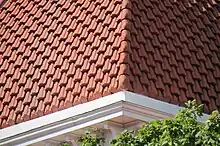
The Conosera tile was developed by George Herman Babcock in 1889, and was a unique due to its diagonally interlocking structure and design allowing for more installation flexibility than other interlocking tile designs.[48]
Conosera was initially manufactured and sold by the Celadon Terra Cotta Company of Alfred, New York. After a merger formed the Ludowici-Celadon Company in 1906 the group continued to produce Conosera tile for special orders.[49]
Concrete tiles
In the 1840s, Adolph Kroher visited Grassau, Bavaria and learned about local's use of regional minerals to create stucco. At some point in this decade he began to experiment with the material and developed a diamond-shaped interlocking pattern of concrete tile which became one of his company's primary profiles. Kroher also manufactured a concrete pantile similar to the Scandinavian style of clay tile.

In order to reduce the high shipping cost for his tile, Kroher adopted a 'do-it-yourself' method of tile manufacture for some time, where he sold a supply of cement and the necessary tools for a home-builder to create their own tiles. This had the disadvantage that cement was prepared by amateurs and did not always have consistent or correct mixing preparation.
Concrete tiles became more widespread in Germany over the next few decades after manufacturers such as Jörgen Peter Jörgensen and Hartwig Hüser began producing interlocking and overlapping designs.[50]
The concrete tile industry grew and spread internationally through the early 20th century, driven by its cheapness to produce at scale.[51] Researchers considered concrete tile inferior to clay tile, largely due to its fundamental weaknesses of porosity and color impermanence.[52][53]
Plastic tiles
Plastic tiles, marketed as composite or synthetic tiles, became available towards the end of the 20th century. Their exact invention date is unclear, but most became available around the year 2000.[54][55]
Plastic tiles are generally designed to imitate slate or clay tiles, and achieve their color through synthetic dyes added to the plastic. They are produced through injection molding.[56]
Solar tiles
Dow Chemical Company began producing solar roof tiles in 2005, and several other manufacturers followed suit. They are similar in design to conventional roof tiles but with a photovoltaic cell within in order to generate renewable electricity.
In 2016 a collaboration between the companies SolarCity and Tesla produced a hydrographically printed tile which appears to be a regular tile from street level but is transparent to sunlight when viewed straight on.[57]Tesla later acquired SolarCity and the solar shingle product was described as "a flop" in 2019.[58] The company later dropped their claim that their tiles were three times as strong as standard tiles, without specifying why they backed away from the claim.[59]
Fittings and trim
Tile roofs require fittings and trim pieces to seal gaps along the ridge and edges of a roof.
Ridge pieces
Ridge pieces are laid upon the very top ridge of a roof, where the planes of a pitched roof meet. This section is usually parallel to the ground beneath.
The tiles which cover this section of the roof have to direct water away from the top of the ridge and onto either side of the pitched roof below.[60]
Finials
Finials are ridge tile fittings that are used on the gable end or apex of a roof. In some cases these can be highly decorative, taking the form of a sculpture or figurine, while in others they can be more practical and architectural in nature.[61]
The term finial is used whether a piece is an endcap at the end of a gable or the cap on top of a tower.
Graduated tiles
Graduated roof tiles are tiles designed to "graduate" in size from top to bottom, with smaller tiles at the top and larger ones at the bottom. They are necessary when installing a tile roof on a tower, cone, or dome and need to be specially designed for each roof they are used on for effective functionality.
Antefix
An antefix is a vertical block which terminates and conceals the base of a mission, imbrex and tegula, or pantile roof.[62]
They are commonly a fixture of Greek and Roman tile roofs and can often be highly ornamental.
Durability
The durability of roofing tiles varies greatly based on material composition and manufacture. Durability is directly related to three factors; a resistance to chemical decomposition, a low porosity, and a high breaking strength.
Chemical decomposition
Clay and slate tiles are stable materials and naturally resistant to chemical decomposition, however plastic composite tiles and concrete tiles will experience inevitable decay over time. As a result of this, high-quality clay and slate tiles have a proven lifespan of over 100 years, whereas synthetic and concrete tiles usually have a practical lifespan of 30-50 years.[63][64][65] In the case of synthetic plastic tiles, this is purely an estimation since the oldest products on the market date to around 2000.[66] The main cause of plastic tile decay is exposure to ultraviolet radiation, which weakens the chemical bonds of the material and causes the tiles to become more brittle over time.[67][68]
A common effect seen in cement roof tiles is efflorescence, which is caused by the presence of free lime within concrete. This lime reacts with water to form calcium hydroxide, which creates a chalky deposit on the outside of the tiles. While not detrimental to the strength or durability of the cement tiles, this effect is considered unappealing.[69]
Porosity
Tiles with a porosity above 2% allow for intrusion and absorption of water, which can be detrimental in climates with freeze-thaw conditions or salt air intrusion. During a freeze-thaw cycle, water that infiltrates a tile will see volume expansions of 9% upon freezing, which exerts pressure within any pores it manages to enter and causes cracks to grow. When the ice melts, water spreads further into those cracks and will then apply more stress to them upon the next freeze.[70] A similar effect can be seen in areas near the ocean that experience salt-air intrusion, which can lead to salt crystal permeation and expansion.[71]
Clay tile porosity can range greatly depending on quality of production, but some manufacturers can achieve less than 2% moisture absorption. Concrete roof tiles tend to feature around 13% moisture absorption, which requires periodic resealing every 3-7 years to avoid critical failure.[72][73] The inherent porosity of cement requires that cement tiles are made very heavy and thick, as a result they have continuously been one of the heaviest roofing materials in the market.[74]
It is commonly believed that a porous clay tile can be waterproofed through the application of a glaze, however studies have showed that this is not the case. If a clay body contains significant pores, water will permeate them over time regardless of exterior coating.[75]
Breaking strength
The breaking strength of clay tiles can vary greatly by manufacturer, depending on a combination of factors such as their firing temperature, specific clay composition, and length of the firing cycle. Despite the common conception of clay tiles being fragile, higher-grade manufacturers produce tiles with breaking strengths ranging from 700 to 1500 pounds.[76]
The breaking strength of plastic roof tiles varies greatly depending on temperature. Unlike ceramics or metals, plastics have glass transition temperatures that fall within the range of winter temperatures, often resulting in them becoming extremely brittle during colder periods.[77]
Color
Clay roof tiles historically gained their color purely from the clay that they were composed of, resulting in largely red, orange, and tan colored roofs. Over time some cultures, notably in Asia, began to apply glazes to clay tiles, achieving a wide variety of colors and combinations.
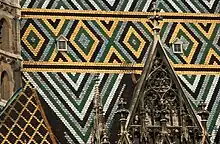
Originally, most color variation on matte clay tiles was caused by variation in kiln firing temperature, kiln atmospheric conditions, and in some cases reductive firing. Many producers have shifted away from this process since low firing temperatures typically result in a lower porosity and breaking strength.
Engobes are now commonly used to replicate the appearance of historic firing variation, using a thin colored ceramic coating which chemically bonds to the tile to provide any range of matte colors to the fired tiles while allowing consistent firing conditions. Glazes are used when a shinier gloss appearance is desired. Like their clay base, both engobes and glazes are fully impervious to color fading regardless of UV exposure, which makes them unique among artificial colorants.[78]
The color of slate tiles is a result of the amount and type of iron and organic material that are present, and most often ranges from light to dark gray. Some shades of slate used for roofing can be shades of green, red, black, purple, and brown.[79]
Cement tiles typically are colored either through the use of a pigment added to the cement body, or through a concentrated slurry coat of cement-infused pigment on the outside of the tiles. Due to the simple production process and comparatively low firing temperature, cement tiles fade over time and often require painting to restore a "new" appearance.[80]
Plastic tiles are colored through the incorporation of synthetic dyes added to them during molding.[81] As a result of their reactive chemical composition they can suffer degradation from UV rays and fade after a few years of use.[82]
Gallery
 Frost on interlocking roof tiles in Britain
Frost on interlocking roof tiles in Britain Underside of mission tile roof in Brazil, installed without underlayment or understructure
Underside of mission tile roof in Brazil, installed without underlayment or understructure Slate tile roof in Norway
Slate tile roof in Norway Modern tile press in Europe
Modern tile press in Europe Interlocking tile designed to look like pantile
Interlocking tile designed to look like pantile Gloss blue roof tiles in Japan
Gloss blue roof tiles in Japan
See also
- Roof tile−related topics
References
- "Shingle Tile Installation Manual" (PDF). Ludowici Roof Tile. 2022.
- "Shingle Tile Installation Manual" (PDF). Ludowici Roof Tile. 2022.
- Warry, Peter (2006). Tegulae Manufacture, Typology and Use in Roman Britain. Oxford, England: Archaeopress. ISBN 1-84171-956-0.
- Lewis, Miles. "Marseille roofing tiles". The University of Melbourne. Retrieved 24 September 2023.
- [Catalogue] Celadon Roofing Tile Co. Ludowici-Celadon Company. 1909. p. 7.
- "Interlocking Tile Installation Manual" (PDF). Ludowici Roof Tile. 2022.
-
Woods, Michael; Woods, Mary B. (January 2000). Ancient Construction: From Tents to Towers. Ancient technology. Minneapolis: Twenty-First Century Books (published 2000). p. 25. ISBN 9780822529989. Retrieved 2018-10-18.
Because of the thatched roof's drawbacks, the development of clay roofing tiles was a great advance in building technology. The advance happened in Mesopotamia. Clay tiles, fired like pottery, were longer lasting and more waterproof than thatch.
- Kenoyer, J.M (2015). Cambridge Histories Online: Indus Valley Civilization. Cambridge University press. pp. 416–17.
- Amalananda Ghosh (ed.). "Excavations at Alamgirpur". Indian Archaeology, A Review (1958-1959). Delhi: Archaeological Survey of India. pp. 51–52.
- Van Lemmen, Hans (2013). 5000 Years of Tiles. Smithsonian Books. p. 29.
- 李誡; 陶湘; 朱啓鈐 (1925). "Glazed tiles". 李明仲營造法式: 36卷 (in Chinese). OCLC 975239953.
- Van Lemmen, Hans (2013). 5000 Years of Tiles. Smithsonian Books. p. 29.
- "onigawara 鬼瓦." JAANUS. Retrieved on June 12, 2009.
- Hall, Emma Doddrell. "Discovering The History Of Traditional Korean Roof Tiles". koreanrooftop.com. Korean Rooftop. Retrieved 24 September 2023.
- Joseph W. Shaw, The Early Helladic II Corridor House: Development and Form, American Journal of Archaeology, Vol. 91, No. 1. (Jan. 1987), pp. 59–79 (59)
- John C. Overbeck, “Greek Towns of the Early Bronze Age”, The Classical Journal, Vol. 65, No. 1. (Oct. 1969), pp. 1–7 (5)
- J. L. Caskey, "Lerna in the Early Bronze Age", American Journal of Archaeology, Vol. 72, No. 4. (Oct. 1968), pp. 313-316 (314)
- Ione Mylonas Shear, "Excavations on the Acropolis of Midea: Results of the Greek-Swedish Excavations under the Direction of Katie Demakopoulou and Paul åström", American Journal of Archaeology, Vol. 104, No. 1. (Jan. 2000), pp. 133–134
- Örjan Wikander, p. 285
- Örjan Wikander, p. 286
- Rostoker; Gebhard, William; Elizabeth (1981). "The archaic roof tiles at Isthmia: a re-examination" (PDF). Journal of Field Archaeology.
{{cite journal}}: CS1 maint: multiple names: authors list (link) - Örjan Wikander, p. 289
- Marilyn Y. Goldberg, p. 309
- Marilyn Y. Goldberg, p. 305
- Barry, William D. (1996). "Roof Tiles and Urban Violence In the Ancient World". Greek, Roman and Byzantine Studies. Duke University: 55.
- Barry, William D. (1996). "Roof Tiles and Urban Violence In the Ancient World". Greek, Roman and Byzantine Studies. Duke University: 60.
- Van Lemmen, Hans (2013). 5000 Years of Tiles. Smithsonian Books. p. 23.
- McWhirr, Alan David (1983). "The production and distribution of brick and tile in Roman Britain". University of Leicester. Retrieved 24 September 2023.
{{cite journal}}: Cite journal requires|journal=(help) - McWhirr, Alan David (1983). "The production and distribution of brick and tile in Roman Britain". University of Leicester. Retrieved 24 September 2023.
{{cite journal}}: Cite journal requires|journal=(help) - Van Lemmen, Hans (2013). 5000 Years of Tiles. Smithsonian Books. p. 92.
- Donnely, Marian C. (1991). "6". Architecture in the Scandinavian Countries (PDF). The MIT Press. p. 54.
- Stephen Emmitt; Christopher A. Gorse (5 February 2013). Barry's Introduction to Construction of Buildings. John Wiley & Sons. p. 208. ISBN 978-1-118-65858-1.
- RW Brunskill, Illustrated Handbook of Vernacular Architecture (1970:58-61)
- Worcester, Wolsey Garnet (1910). texts The Manufacture of Roofing Tiles. Springfield, Ohio: Springfield Publishing Company. p. 13.
- Anne E. Grimmer; Paul K. Williams (1993). "The Preservation and Repair of Historic Clay Tile Roofs" (PDF). Preservation Briefs. National Park Service: 1-4.
- Anne E. Grimmer; Paul K. Williams (1993). "The Preservation and Repair of Historic Clay Tile Roofs" (PDF). Preservation Briefs. National Park Service: 3.
- Varman, Robert (2006). "The Marseille or French pattern tile in Australia" (PDF). The Australian Society for Historical Archaeology. Retrieved 24 September 2023.
- Brunner, Jan. "Falzziegelwerk Carl Ludowici". Institut für Geschichtliche Landeskunde. Retrieved 28 March 2023.
- R.V.J. Varman (2006). "The Marseilles or French Pattern Tile in Australia" (PDF). Australian Society for Historical Archaeology.
- "A New Church". paperspast.natlib.govt.nz. New Zealand Times. 17 July 1899. Retrieved 2023-05-07.
- "Kaiwarra Station". paperspast.natlib.govt.nz. New Zealand Times. 11 October 1901. Retrieved 2023-05-07.
- "The New Dunedin Railway Station". paperspast.natlib.govt.nz. Evening Star. 14 November 1900. Retrieved 2023-05-07.
- "historique gilardoni". www.patrimoineindustriel-apic.com. Retrieved 2023-05-07.
- "Otago Witness". paperspast.natlib.govt.nz. 15 October 1929. Retrieved 2023-05-07.
- "New Zealand Goods". paperspast.natlib.govt.nz. Dominion. 28 October 1921. Retrieved 2023-05-07.
- "The Red Clay Rooves [sic] Of Timaru". Civic Trust. 13 November 2019. Retrieved 2023-05-07.
- "Marseille Clay Roof Tile". Macmillan Slaters and Tilers Ltd. Retrieved 2023-05-07.
- Artistic Roofing Tiles. Alfred, NY: Celadon Roofing Tile Company. 1899. pp. 48–49. Retrieved 28 March 2023.
- Clawson, Cortez (1926). History of the Town of Alfred, New York from the Earliest Times to the Present (PDF). Alfred, New York: Sun Publishing Association. pp. 72–73. Retrieved 28 March 2023.
- Dobson, Charles (1959). The History of the Concrete Roofing Tile. Its Origins and Development in Germany. London, England: B.T. Batsford.
- "Concrete Roofing Tile". Roofing for Historic Buildings. National Park Service. Retrieved 25 September 2023.
- Worcester, Wolsey Garnet (1910). The Manufacture of Roofing Tiles. Springfield, Ohio: Springfield Publishing Co. p. 28.
- Farhan, Syed Ahmad; Ismail, Fouad Ismail; Kiwan, Osamah; Shafiq, Nasir; Zain-Ahmed, Azni; Husna, Nadzhratul; Hamid, Afif Izwan Abd (2021). "Effect of Roof Tile Colour on Heat Conduction Transfer, Roof-Top Surface Temperature and Cooling Load in Modern Residential Buildings under the Tropical Climate of Malaysia". Sustainability. 13 (9): 4665. doi:10.3390/su13094665.
- "Company History". DaVinci Roofscapes. Retrieved 25 September 2023.
- Theriault, Melanie. "Everything You Need to Know About Synthetic Roofing". New Home Source. Builders Digital Experience, LLC.
- Mumtaz Ahmad; Mohammad Waseem (2021). "Effects of injection molding parameters on cellular structure of roofing tiles composite". Materials Today: Proceedings. 36: 701-707.
- Becker, Rachel (29 October 2016). "Check out Tesla's four different glass solar roofs". The Verge.
- "Tesla's trumpeted solar shingles are a flop". MIT Technology Review. Retrieved 2023-07-12.
- Lambert, Fred (October 18, 2021). "Tesla drops claim that solar roof tiles are '3x stronger than standard tiles'". Electrek. 9to5. Retrieved 30 September 2023.
- "How to fix ridge tiles". Roofing Superstore Help & Advice. Retrieved 29 September 2023.
- Essley, Joffre. "Definition of finial". House Design Coffee. Retrieved 29 September 2023.
- Chisholm, Hugh, ed. (1911). . Encyclopædia Britannica. Vol. 2 (11th ed.). Cambridge University Press. p. 89.
- Mazzuca, John (February 14, 2021). "Concrete Vs Clay Tile Roof". gambrick.com. Gambrick Construction.
- Newcomb, Rachel (June 30, 2023). "Clay Tile Roofing Guide". Condé Nast. Architectural Digest.
- "Concrete Tile Roof Cost: Boral & Eagle Roofing Tiles Pricing". Roofing Calculator. Roofing Calculator Inc. July 30, 2023.
- Theriault, Melanie. "Everything You Need to Know About Synthetic Roofing". New Home Source. Builders Digital Experience, LLC.
- "Are DaVinci Polymer Roof Tiles Color Stable?". davinciroofscapes.com. Westlake DaVinci Roofscapes, LLC.
- Taylor, Rod (January 23, 2021). "Why does plastic become brittle as it ages?". The Canberra Times.
- "Efflorescence on Roofing Tiles" (PDF). tileroofing.com. Tile Roofing Industry Alliance. Retrieved 9 October 2023.
- William Carty; Hyojin Lee (August 16, 2017). "Ceramics for Exterior Applications & A Discussion of Heat Transfer and Storage" (PDF). Boston Valley Terra Cotta.
- "Does Saltwater Effect Roof Tiles?". Vivify Roofing. July 2, 2021. Retrieved 5 October 2023.
- "Why Ludowici". ludowici.com. Ludowici Roof Tile, LLC. Retrieved 5 October 2023.
- "Concrete Tile Roof Cost: Boral & Eagle Roofing Tiles Pricing". Roofing Calculator. Roofing Calculator Inc. July 30, 2023.
- Worcester, Wolsey Garnett (1910). The Manufacture of Roofing Tile. Springfield, Ohio: Springfield Publishing Company. p. 28.
- William Carty; Hyojin Lee (August 16, 2017). "Ceramics for Exterior Applications & A Discussion of Heat Transfer and Storage" (PDF). Boston Valley Terra Cotta.
- "Breaking Strength". ludowici.com. Ludowici. Retrieved 9 October 2023.
- "Low Temperature Properties of Polymers" (PDF). Zeus Industrial Products, Inc.
- Worcester, Wolsey Garnett (1910). The Manufacture of Roofing Tile. Springfield, Ohio: Springfield Publishing Company. pp. 27–28, 93–94.
- King, Hobart M. "Slate". geology.com.
- "Simple Facts about your Concrete Tile Roof" (PDF). eagleroofing.com. Eagle Roofing Products. 2015.
- Mumtaz Ahmad; Mohammad Waseem (2021). "Effects of injection molding parameters on cellular structure of roofing tiles composite". Materials Today: Proceedings. 36: 701-707.
- Frost, Shelley. "Synthetic Slate Roof Shingles: A Cost and Buyer's Guide". Hunker. Leafgroup LTD.
External links
- Technical note on peg tile restoration work
 Media related to Roof tiles at Wikimedia Commons
Media related to Roof tiles at Wikimedia Commons
